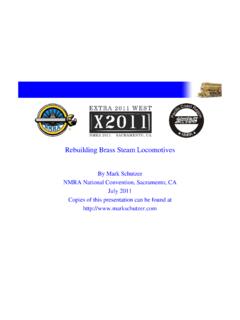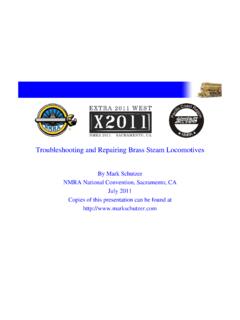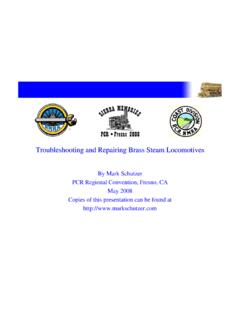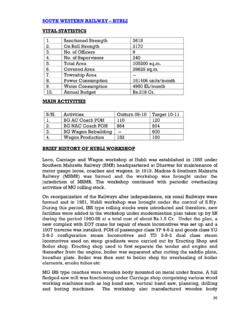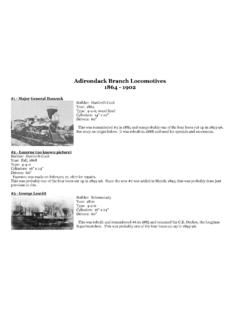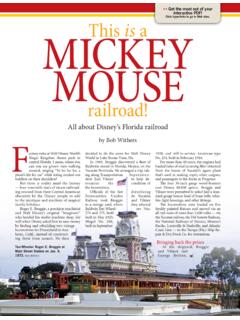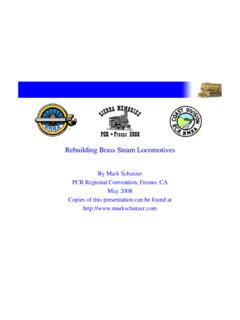Transcription of Rebuilding Brass Steam Locomotives - Mark's Web Site
1 Rebuilding Brass Steam LocomotivesRebuilding Brass Steam LocomotivesBy Mark SchutzerPCR Regional Convention, Sacramento, CAMay 2006 Copies of this presentation can be found 16, 2006 Rebuilding Brass Mark Schutzer2 Clinic OverviewsClinic OverviewsPart 1 Troubleshooting and Repairing Brass Steam Locomotives have a reputation for running poorly. This clinic will discuss the common problems and show you how to fix them. A step by step example of a locomotive repair will be illustrated. This clinic is tailored to the beginner who wants learn how to improve the running of those cranky Steam 2 Rebuilding Steam Locomotives This clinic will show you how to turn those noisy growlers into prize runners that will silently creep down the track. Re-motoring and re-gearing will be discussed and illustrated in detail. Topics include motor and gearbox selection, motor mount construction, and the use of universal joint couplings.
2 April 16, 2006 Rebuilding Brass Mark Schutzer3 The tale of three KTM tale of three KTM quick little demonstrationMountain 4355 Original condition, as obtainedMountain 4342 Clinic example for part 2 Re-motored Re-gearedMountain 4347 After completion of clinic s 1 and 2 Re-motored Re-geared Universal coupling Decoder equippedApril 16, 2006 Rebuilding Brass Mark Schutzer4 Problem AreasProblem AreasMotorsGearboxesRigid motor to gearbox couplingsApril 16, 2006 Rebuilding Brass Mark Schutzer5 Motor IssuesMotor IssuesMotor Issues Most early (1950 s through mid 1970 s) Brass Locomotives are equipped with open frame motors. Most of these motors have very poor starting torque resulting in a higher starting voltage. As a result it is almost impossible to get slow prototypical starting of a locomotive . The increased starting voltage causes the locomotive to lurch to a unrealistic start.
3 Once running the voltage can be reduced to slow the locomotive down, but it won t run well due to the poor slow speed torque of the motor. These motors are very inefficient by today s standards and consumed lots of current. Typical stall currents for these motors are in the range of two amps or more. These high stall currents are not compatible with HO scale DCC decoders. As a result of the higher running speed of these motors large gearbox reduction ratio s (37:1 or greater) are typically used. At higher locomotive speeds this results in noisy operation in part due to the high operating speed of motor and 16, 2006 Rebuilding Brass Mark Schutzer6 Original MotorsOriginal MotorsSome typical open frame motor or > or or Current(Amps)12 voltsTypical loadedCurrent (Amps)12 voltsFree RunningCurrent (Amps)12 voltsMotor TypeOpen FrameKTMA pril 16, 2006 Rebuilding Brass Mark Schutzer7 Gearbox IssuesGearbox IssuesGearbox issues Most early gearboxes run noisy due to large space tolerances between the gears.
4 The early square cut worms are inherently noisy. A lot of the early gearboxes used both steel worms and steel worm gears, and the steel on steel also resulted in noisier operation. Many original gearboxes have high reduction ratios to make up for poor motor performance. The higher operating speeds also cause noisyoperation. A lot of the earlier models use open gearboxes, or open gears which are both noisy and messy as the lubrication ended up all over. A lot of early gearboxes are poorly made and just don t work well. A modern precision made gearbox should run nearly silent, even at high locomotive speedsApril 16, 2006 Rebuilding Brass Mark Schutzer8 Coupling IssuesCoupling IssuesRigid motor to gearbox couplings Most early Brass Locomotives make use of a piece of plastic or rubber tubing to couple the motor to the gearbox. This tubing forms a rigid coupling between the motor and the gearbox.
5 The basic issue is gearbox motion Up and down motion due to sprung axles. Side to side motion due to axle shifting on curves. Motion due to residual wobble. The rigid coupling restricts the free motion of the gearbox causing noise and 16, 2006 Rebuilding Brass Mark Schutzer9 Coupling IssuesCoupling IssuesOpen worm on motor shaft Another common technique used on early Locomotives had the worm soldered directly on the motor shaft. An open worm gear was used on the driven axle. The motor was mounted such that the open worm was suspended above and in contact with the worm gear. Common with un-sprung drivers. There are a few problems with this scheme, first it is difficult to maintain proper worm to gear mesh, the open gears are noisy, and you can t properly lubricate the gears without oil, and or grease flying all over the place. April 16, 2006 Rebuilding Brass Mark Schutzer10 Coupling IssuesCoupling IssuesMetal Universals Many of the larger old articulated Locomotives used metal universal joints in portions of their drivelines.
6 These old metal parts ran noisy, and sometimes only a single ball and cup joint would be used, requiring critical alignment to work without 16, 2006 Rebuilding Brass Mark Schutzer12 Rebuilding OverviewRebuilding OverviewMotorsMotor MountsGearboxesDrivers and GearsCoupling MethodsTorque ArmsFlywheelsBalancingApril 16, 2006 Rebuilding Brass Mark Schutzer13 MotorsMotorsCan motor advantages More efficient, much lower current draw Most are skew wound for very good slow speed performance Slower starting speeds and excellent slow speed torque Better slow speed performance allows lower gearbox ratios to be used reducing the top end noise. DCC friendly; isolated terminals, and most HO sized motors have stall currents under or about 1 the largest size motor that will fit in the flat can types when your firebox area is motors to choose NWSL Sagami Mashima A line Proto Power West CannonApril 16, 2006 Rebuilding Brass Mark Schutzer14 MotorsMotorsCan motor selectionApril 16, 2006 Rebuilding Brass Mark Schutzer15 Can MotorsCan MotorsSome typical can motor Torque ( ) Current(Amps)12 voltsMax.
7 ContinuousCurrent (Amps)12 voltsFree RunningCurrent (Amps)12 voltsMotor TypeNWSLA pril 16, 2006 Rebuilding Brass Mark Schutzer16 Motor MountsMotor MountsMotor Mounting The new motor needs to be installed and secured to the locomotive s frame. Motor needs to be removable for servicing. Mount should allow for minor adjustments in the motor position. Mount should provide for some isolation of the motor s Universal motor cradle fabricated from Brass . Motor attached to cradle with Silicon Rubber sealant. Motor cradle attached to frame with the original motor mounting 16, 2006 Rebuilding Brass Mark Schutzer17 Motor CradlesMotor CradlesMotor Cradle fabrication Base made from .062 x .5 Brass bar stock. Sides made from .125 x .125 angle stock. Solder together. Drill and tap hole in the base to line up with hole in frame. Milled version as alternativeApril 16, 2006 Rebuilding Brass Mark Schutzer18 GearboxesGearboxesReplacement Gearboxes A large selection of precision gearboxes available from NWSL.
8 Standard gear ratios of 28:1 and 36:1 Most common HO sizes; mod for small Locomotives , mod formedium to large Locomotives Non idler, Idler, Double Idler, and High/Low types available All precision machined gears for silent operationTips Read the instructions carefully the first time. Sand gearbox bottom to eliminate excess axle play. Run a tap through all the holes to make it easier to install the screws. Make sure that worm shaft bearings are snug in gearbox. You may have to sand a little bit of a taper on one of the gearbox halves to assure snug worm shaft bearings for some gearbox models. See assembly write-up on my websiteApril 16, 2006 Rebuilding Brass Mark Schutzer19 GearboxesGearboxesNew Gearbox ChoicesApril 16, 2006 Rebuilding Brass Mark Schutzer20 Pulling Drivers and GearsPulling Drivers and GearsNWSL PullerArbor Press NWSL Sensipress PanaVise pressApril 16, 2006 Rebuilding Brass Mark Schutzer21 Pressing GearsPressing GearsArbor Press NWSL Sensipress PanaVise pressNWSL Gear AlignersApril 16, 2006 Rebuilding Brass Mark Schutzer22 Quartering ToolsQuartering ToolsNWSL QuartererNWSL Quarterer 2 Quartering viseApril 16, 2006 Rebuilding Brass Mark Schutzer23 Pressing DriversPressing DriversQuarteringApril 16.
9 2006 Rebuilding Brass Mark Schutzer24 Coupling MethodsCoupling MethodsRubber Couplings Can successfully be used in some rigid torque arm applications, but motor to gear box alignment critical. Universal joints recommended shaft direct through gearbox Can be used in some applications. Eliminates alignment issues. Not practical for non idler gearboxes. Space issues, large motor close to joints Preferred method, but requires torque arm. Non rigid connection between motor and gearbox. Works well even with some misalignments, keep angles to under 15 degrees per joint. Runs very quiet. Isolates gearbox from motor. April 16, 2006 Rebuilding Brass Mark Schutzer25 Universal JointsUniversal JointsWide variety of choices available from sizes to support all the common shaft sizes; mm, mm, and shafting material also available from 16, 2006 Rebuilding Brass Mark Schutzer26 Torque ArmsTorque ArmsA torque arm is needed to keep the gearbox from rotating when using universal joint prefer an overhead torque arm with a pivot point at the motor Make from.
10 016 Brass sheet stock About .2 wide Bend as needed to fit application Drill two holes on gearbox end, drill and tap holes in gearbox to match ( mm screws). Drill clearance hole on motor end to line up with the front motor mounting hole (2 mm screw). Use 2mm screw on motor end with a clearance spacer washer or a shouldered screw. Put plastic or fiber washer between motor and torque arm to prevent metal on metal noise when motor 16, 2006 Rebuilding Brass Mark Schutzer27 Torque ArmsTorque ArmsAdvantages of this design Keeps gearbox from rotating. Gearbox is allowed to freely move up and down due to long thin torque arm. Gearbox is free to move side to side due to the torque arm pivot point on the motor. Gearbox moves freely to follow axle motion. Simple and fairly easy to construct. Works very well!April 16, 2006 Rebuilding Brass Mark Schutzer28 FlywheelsFlywheelsConsider adding a flywheel if space allows Improves performance, allows locomotive to coast over bad contact areas Can help slow speed performance as motor has larger rotating mass Consider it as optional when space allows Flywheels don t have to be constant size, can be made to fit 16, 2006 Rebuilding Brass Mark Schutzer29 BalancingBalancingBalancing For the best overall performance the locomotive should be roughly balanced over the center point of the drivers.
